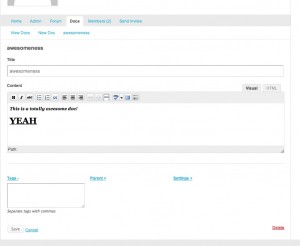The BuddyPress Group Documents plugin allows groups a handy way for users to share documents with fellow members of a BP group. It’s crucial to the work that is done on the CUNY Academic Commons. But, by default, the plugin stores documents in a subdirectory of your WP uploads folder (usually /wp-content/blogs.dir/ on multisite). That means that documents are available directly, to anyone who has the URL, regardless of the public/private/hidden status of groups. This isn’t a problem from within BuddyPress, since URLs for the documents only appear inside of the protected group interface. But if the URL is shared, then the document becomes publicly available. Worse, if someone posts the URL of a document in a public place, search engine bots will find it, and the contents of the document could end up in Google.
I wrote a few helper functions to change this behavior. The strategy is this: Move the files so that they are not accessible via URL, ie in a directory above the web root. (In my case, it’s a directory called bp-group-documents, just above my web root.) Then, catch requests of a certain type (I’ve chosen to go with a URL parameter get_group_doc=), and check them to see whether the current user has the adequate permission to access the document in question. Finally, make sure that all of the URLs and paths that BPGD uses to upload and display documents are filtered to the updated versions. I’ve provided my code below – use and modify at your pleasure. You should be able to place it in your plugins/bp-custom.php file, and then move your existing docs from their current location (probably something like wp-content/blogs.dir/1/files/group-documents) to the new directory.
I also added a line to my .htaccess file to ensure that requests to the old URLs are redirected to the new, hardened URL. That line is this:
[code]
RewriteRule ^wp-content/blogs.dir/1/files/group-documents/(.*) /?get_group_doc=$1 [R,L]
[/code]
Obviously, you may have to modify it for different file paths.
EDITED Feb 8, 2011 to include the code for creating directories when none exist
[code language=”php”]
define( ‘BP_GROUP_DOCUMENTS_SECURE_PATH’, substr( ABSPATH, 0, strrpos( rtrim( ABSPATH, ‘/’ ), ‘/’ ) ) . ‘/bp-group-documents/’ );
function cac_filter_doc_url( $doc_url, $group_id, $file ) {
$url = bp_get_root_domain() . ‘?get_group_doc=’ . $group_id . ‘/’ . $file;
return $url;
}
add_filter( ‘bp_group_documents_file_url’, ‘cac_filter_doc_url’, 10, 3 );
function cac_filter_doc_path( $doc_url, $group_id, $file ) {
$document_dir = BP_GROUP_DOCUMENTS_SECURE_PATH . $group_id . ‘/’;
if ( !is_dir( $document_dir ) )
mkdir( $document_dir, 0755, true );
$path = BP_GROUP_DOCUMENTS_SECURE_PATH . $group_id . ‘/’ . $file;
return $path;
}
add_filter( ‘bp_group_documents_file_path’, ‘cac_filter_doc_path’, 10, 3 );
function cac_catch_group_doc_request() {
$error = false;
if ( empty( $_GET[‘get_group_doc’] ) )
return;
$doc_id = $_GET[‘get_group_doc’];
// Check to see whether the current user has access to the doc in question
$file_deets = explode( ‘/’, $doc_id );
$group_id = $file_deets[0];
$group = new BP_Groups_Group( $group_id );
if ( empty( $group->id ) ) {
$error = array(
‘message’ => ‘That group does not exist.’,
‘redirect’ => bp_get_root_domain()
);
} else {
if ( $group->status != ‘public’ ) {
// If the group is not public, then the user must be logged in and
// a member of the group to download the document
if ( !is_user_logged_in() || !groups_is_user_member( bp_loggedin_user_id(), $group_id ) ) {
$error = array(
‘message’ => sprintf( ‘You must be a logged-in member of the group %s to access this document. If you are a member of the group, please log into the site and try again.’, $group->name ),
‘redirect’ => bp_get_group_permalink( $group )
);
}
}
// If we have gotten this far without an error, then the download can go through
if ( !$error ) {
$doc_path = BP_GROUP_DOCUMENTS_SECURE_PATH . $doc_id;
if ( file_exists( $doc_path ) ) {
$mime_type = mime_content_type( $doc_path );
$doc_size = filesize( $doc_path );
header(“Cache-Control: public, must-revalidate, post-check=0, pre-check=0”);
header(“Pragma: hack”);
header(“Content-Type: $mime_type; name='” . $file_deets[1] . “‘”);
header(“Content-Length: ” . $doc_size );
header(‘Content-Disposition: attachment; filename=”‘ . $file_deets[1] . ‘”‘);
header(“Content-Transfer-Encoding: binary”);
ob_clean();
flush();
readfile( $doc_path );
die();
} else {
// File does not exist
$error = array(
‘message’ => ‘The file could not be found.’,
‘redirect’ => bp_get_group_permalink( $group ) . ‘/documents’
);
}
}
}
// If we have gotten this far, there was an error. Add a message and redirect
bp_core_add_message( $error[‘message’], ‘error’ );
bp_core_redirect( $error[‘redirect’] );
}
add_filter( ‘wp’, ‘cac_catch_group_doc_request’, 1 );
// http://www.php.net/manual/en/function.mime-content-type.php#87856
if(!function_exists(‘mime_content_type’)) {
function mime_content_type($filename) {
$mime_types = array(
‘txt’ => ‘text/plain’,
‘htm’ => ‘text/html’,
‘html’ => ‘text/html’,
‘php’ => ‘text/html’,
‘css’ => ‘text/css’,
‘js’ => ‘application/javascript’,
‘json’ => ‘application/json’,
‘xml’ => ‘application/xml’,
‘swf’ => ‘application/x-shockwave-flash’,
‘flv’ => ‘video/x-flv’,
// images
‘png’ => ‘image/png’,
‘jpe’ => ‘image/jpeg’,
‘jpeg’ => ‘image/jpeg’,
‘jpg’ => ‘image/jpeg’,
‘gif’ => ‘image/gif’,
‘bmp’ => ‘image/bmp’,
‘ico’ => ‘image/vnd.microsoft.icon’,
‘tiff’ => ‘image/tiff’,
‘tif’ => ‘image/tiff’,
‘svg’ => ‘image/svg+xml’,
‘svgz’ => ‘image/svg+xml’,
// archives
‘zip’ => ‘application/zip’,
‘rar’ => ‘application/x-rar-compressed’,
‘exe’ => ‘application/x-msdownload’,
‘msi’ => ‘application/x-msdownload’,
‘cab’ => ‘application/vnd.ms-cab-compressed’,
// audio/video
‘mp3’ => ‘audio/mpeg’,
‘qt’ => ‘video/quicktime’,
‘mov’ => ‘video/quicktime’,
// adobe
‘pdf’ => ‘application/pdf’,
‘psd’ => ‘image/vnd.adobe.photoshop’,
‘ai’ => ‘application/postscript’,
‘eps’ => ‘application/postscript’,
‘ps’ => ‘application/postscript’,
// ms office
‘doc’ => ‘application/msword’,
‘rtf’ => ‘application/rtf’,
‘xls’ => ‘application/vnd.ms-excel’,
‘ppt’ => ‘application/vnd.ms-powerpoint’,
// open office
‘odt’ => ‘application/vnd.oasis.opendocument.text’,
‘ods’ => ‘application/vnd.oasis.opendocument.spreadsheet’,
);
$ext = strtolower(array_pop(explode(‘.’,$filename)));
if (array_key_exists($ext, $mime_types)) {
return $mime_types[$ext];
}
elseif (function_exists(‘finfo_open’)) {
$finfo = finfo_open(FILEINFO_MIME);
$mimetype = finfo_file($finfo, $filename);
finfo_close($finfo);
return $mimetype;
}
else {
return ‘application/octet-stream’;
}
}
}
[/code]






